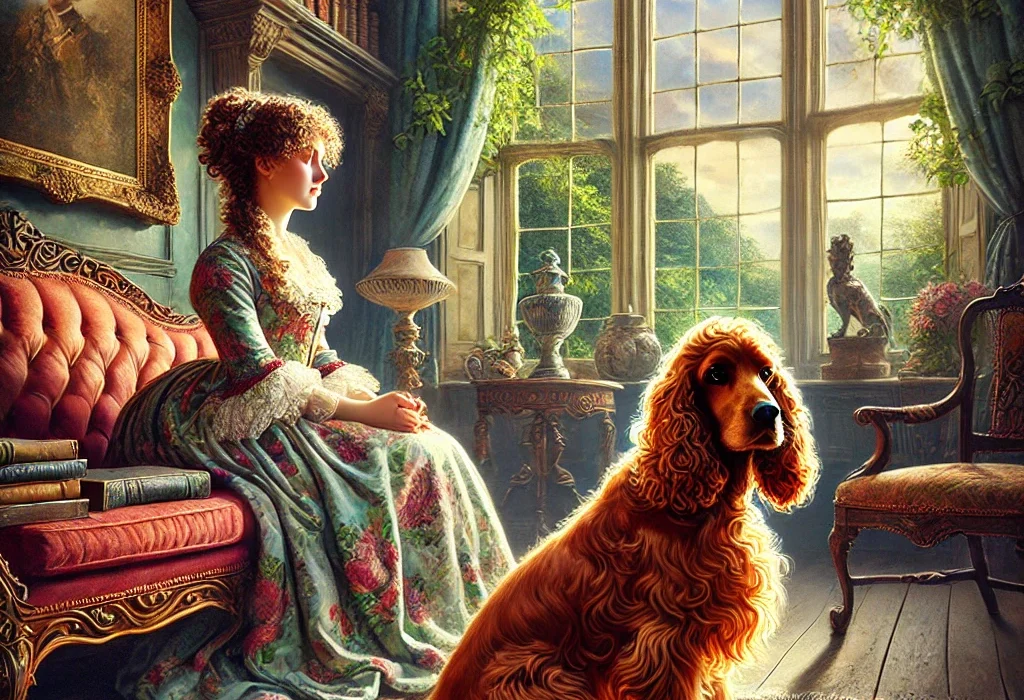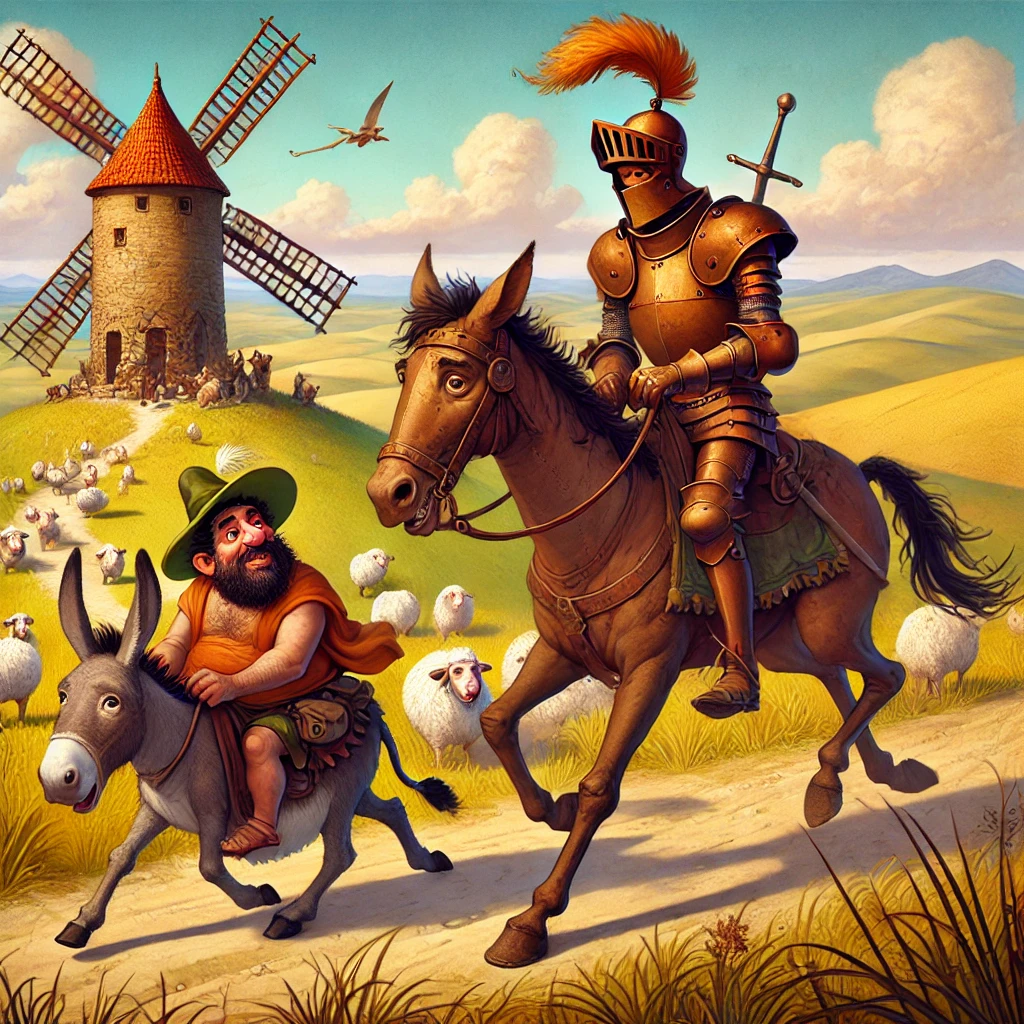Flush: A Biography by Virginia Woolf (published in 1933) tells the whimsical, poignant, and symbolic story of Flush, a cocker spaniel who lives with the poet Elizabeth Barrett Browning. Through this dog’s unique perspective, Woolf delves into themes of freedom, loyalty, and social class, while also examining the complex relationship between humans and animals. Flush’s journey from a carefree life in the countryside to the restrictive city and his eventual liberation mirrors Woolf’s reflections on human constraints, society, and love.
Plot Summary
The house at Three Mile Cross, in the countryside near Reading, is the birthplace of Flush, a golden-brown cocker spaniel with expressive eyes and a rich pedigree that stretches back centuries. Flush grows up with Miss Mitford, a warm-hearted and devoted woman who cares deeply for him. Together, they roam the fields, delighting in the scents of wildflowers and earth. Flush savors the boundless freedom of the countryside, running through fields and feeling the thrill of open spaces. But soon, a dramatic change comes. Miss Mitford, in a gesture of love and kindness, decides to send Flush to her friend Elizabeth Barrett, an invalid poet confined to her bedroom in a somber house on Wimpole Street, London. Unaware of the depth of this sacrifice, Flush leaves the familiar countryside behind.
Flush’s life in the bustling city is a stark contrast to his carefree existence in the country. The once-free dog now finds himself tethered by invisible chains that bind both him and his new mistress. Elizabeth Barrett is fragile and isolated, confined to her room by her father’s oppressive will and her own ill health. The dark, ivy-clad room seems a prison to Flush, who struggles to understand this new world. His first moments in the city are filled with confusion, discomfort, and the sharp, invasive smells of London. Yet he feels a strange kinship with Elizabeth, sensing that both of them are bound by forces beyond their control. In time, their connection deepens, and Flush becomes her constant companion, lying faithfully at her feet. He experiences the nuances of her moods, her occasional bouts of laughter, and her periods of melancholy.
As Flush adjusts to the rhythms of Wimpole Street, he becomes increasingly aware of the social structure around him. He begins to notice the distinctions between the high-born, well-groomed city dogs and the scrappy strays scavenging in the gutters. He learns that, in this world, dogs, like people, are bound by unspoken hierarchies. Flush’s purple water jar, his satin-lined basket, and his chain represent both privilege and confinement, each one a symbol of the roles assigned by society. Flush comes to understand the value of restraint, the meaning of dignity, and the power of obedience, seeing how they shape his life with Elizabeth. But he also senses the weight of these bindings, particularly when he is kept leashed on walks through Regent’s Park, restricted from running freely across the open lawns.
Flush’s loyalty to Elizabeth grows, but it is soon tested by the darker side of London life. One day, while out walking with Elizabeth’s maid Wilson, Flush is attacked and kidnapped by a gang of thieves. Dragged into the filthy slums of Whitechapel, he is held for ransom, subjected to rough handling and dire conditions. Elizabeth, stricken by grief, becomes desperate. Her father refuses to pay for Flush’s return, but Elizabeth, unable to bear the thought of losing her companion, quietly arranges to pay the ransom herself. Wilson retrieves Flush, who returns to Elizabeth’s side, bearing the marks of his ordeal. This brush with freedom and violence leaves a lasting impact on Flush, deepening his understanding of life’s risks and the bond he shares with Elizabeth. Through this trial, he begins to see how both he and Elizabeth are controlled by others’ whims.
As the seasons change, so does the quiet life of Wimpole Street. A new presence, that of the poet Robert Browning, begins to weave its way into Elizabeth’s life, igniting a spark of transformation within her. Flush senses this change with a growing unease. Browning’s letters arrive in a flurry, filling Elizabeth with energy and hope, and when he eventually begins visiting her, their meetings leave her brightened, revived. But to Flush, Browning is an intruder, a rival for Elizabeth’s affection. He watches with jealousy as the poet’s laughter fills the room, as Elizabeth’s health and spirits improve under his influence. Flush resents Browning’s impact, feeling increasingly sidelined as he observes the deepening connection between his beloved mistress and the vigorous, determined poet.
Soon, Flush begins to see how profoundly Browning’s influence disrupts the life Elizabeth once knew. Despite her improved health and heightened spirits, Elizabeth remains under the strict control of her father, who would never approve of her burgeoning romance. But Browning’s boldness encourages her, and she starts to dream of a life beyond Wimpole Street. This idea fills Flush with both excitement and trepidation. He senses a change in Elizabeth—a sense of courage, a renewed hope. The inevitability of her departure becomes a shadow over their lives. Flush watches as she gathers her courage, planning a secret escape with Browning, a plan that would break the chains that bind them both.
Finally, one late summer night, Flush finds himself thrust into an adventure that will change his life forever. Elizabeth, strengthened by her love for Browning, takes her fate into her own hands. Under the cover of night, with Browning’s help, she slips out of Wimpole Street, taking Flush with her. As they make their way through the darkened city streets, Flush feels a rush of exhilaration and terror. London, once a prison, now seems alive with possibility. Flush is a part of Elizabeth’s daring escape, feeling her fear and determination as they make their way to freedom.
Their journey leads them to Italy, where both Flush and Elizabeth experience a liberation beyond anything they have known. The warm, vibrant landscapes of Italy offer Flush a taste of the countryside freedom he once enjoyed at Three Mile Cross. He revels in the open fields and the sun-drenched streets, and for the first time in years, he runs freely, unbound by any chain. Elizabeth, too, flourishes in this new world. No longer confined by her father’s will or London’s strictures, she embraces life with Browning, and they begin a family of their own.
Flush’s days in Italy are filled with joy and a sense of fulfillment he had never imagined. He grows older, but his spirit remains bright, sustained by the love and freedom he shares with Elizabeth. The loyalty and devotion he once felt as duty now become expressions of pure joy. Flush understands that he and Elizabeth have both found a home, not in a place, but in the freedom to live on their own terms. The quiet countryside that marked his early life, the dark confinement of Wimpole Street, and the fierce courage of his time in London’s slums all blend into a rich tapestry of memories that he carries with him as he lays at Elizabeth’s feet, basking in the Italian sun.
Flush’s life, like Elizabeth’s, is no longer bound by the rules of others. In their shared journey from captivity to liberation, they have forged a bond that transcends human and animal, a testament to loyalty, love, and the power of freedom.
Main Characters
- Flush – A loyal, spirited spaniel whose experiences range from the idyllic rural life to the confining, genteel setting of Victorian London. His perspectives, instincts, and evolving emotions provide a moving and unique lens through which human life and social norms are explored.
- Elizabeth Barrett Browning – The renowned poet and owner of Flush, Elizabeth is portrayed as an invalid, restricted by her father and society. Her affection for Flush highlights her sense of compassion, and her relationship with him reflects her own desires for freedom and emotional connection.
- Mr. Barrett – Elizabeth’s controlling father, who represents societal and familial constraints. His influence over Elizabeth’s life contrasts with her yearning for independence, making him a subtle antagonist in Flush’s life as well.
- Robert Browning – A passionate poet and Elizabeth’s lover, whose presence brings both excitement and jealousy into Flush’s life. His relationship with Elizabeth introduces the dog to complex emotions of rivalry and love, as he eventually becomes an ally in the shared desire for her liberation.
Theme
- Freedom vs. Confinement – Flush’s life parallels Elizabeth’s restricted existence under her father’s strict guardianship. The book reflects on the restrictions society imposes on individuals, as both Flush and Elizabeth seek to break free.
- Class and Social Hierarchies – Through the life of a spaniel, Woolf subtly critiques Victorian class structures, comparing the “breed” distinctions among dogs with the rigid human social stratifications.
- Love and Loyalty – Flush’s unwavering loyalty to Elizabeth provides a touching depiction of love, highlighting the emotional depth of animals and drawing parallels between their relationships and human bonds.
- Empathy and Perspective – Woolf’s storytelling from Flush’s viewpoint demonstrates the power of empathy, as readers are led to consider human lives and decisions through an animal’s emotional landscape and instinctual reactions.
Writing Style and Tone
Woolf’s writing in Flush is both poetic and experimental, blending biography, fiction, and social commentary in a light, playful tone that is nevertheless deeply insightful. Her language shifts between simple and richly descriptive, reflecting Flush’s sensory experiences and his evolving understanding of his world. Woolf intersperses humor with melancholy, rendering Flush’s experiences with a tone that is simultaneously whimsical and philosophical.
The tone is characterized by its subtle irony and gentle satire, as Woolf uses Flush’s perspective to critique human society. The simplicity of a dog’s viewpoint allows for a more direct, almost childlike expression of ideas, yet Woolf’s sophisticated narrative style imbues these perceptions with layers of meaning. The novel’s tone balances humor with pathos, inviting readers to reflect on the dignity, loyalty, and love that underpin even the most domesticated of lives.
We hope this summary has sparked your interest and would appreciate you following Celsius 233 on social media:
There’s a treasure trove of other fascinating book summaries waiting for you. Check out our collection of stories that inspire, thrill, and provoke thought, just like this one by checking out the Book Shelf or the Library
Remember, while our summaries capture the essence, they can never replace the full experience of reading the book. If this summary intrigued you, consider diving into the complete story – buy the book and immerse yourself in the author’s original work.
If you want to request a book summary, click here.
When Saurabh is not working/watching football/reading books/traveling, you can reach him via Twitter/X, LinkedIn, or Threads
Restart reading!








